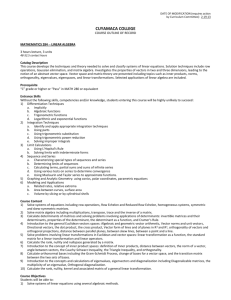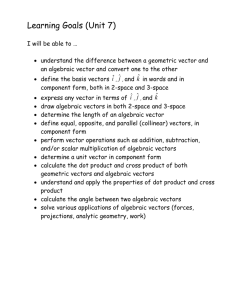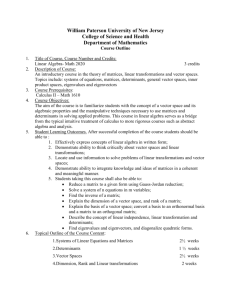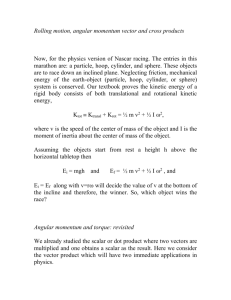Math 284 - Cuyamaca College
advertisement
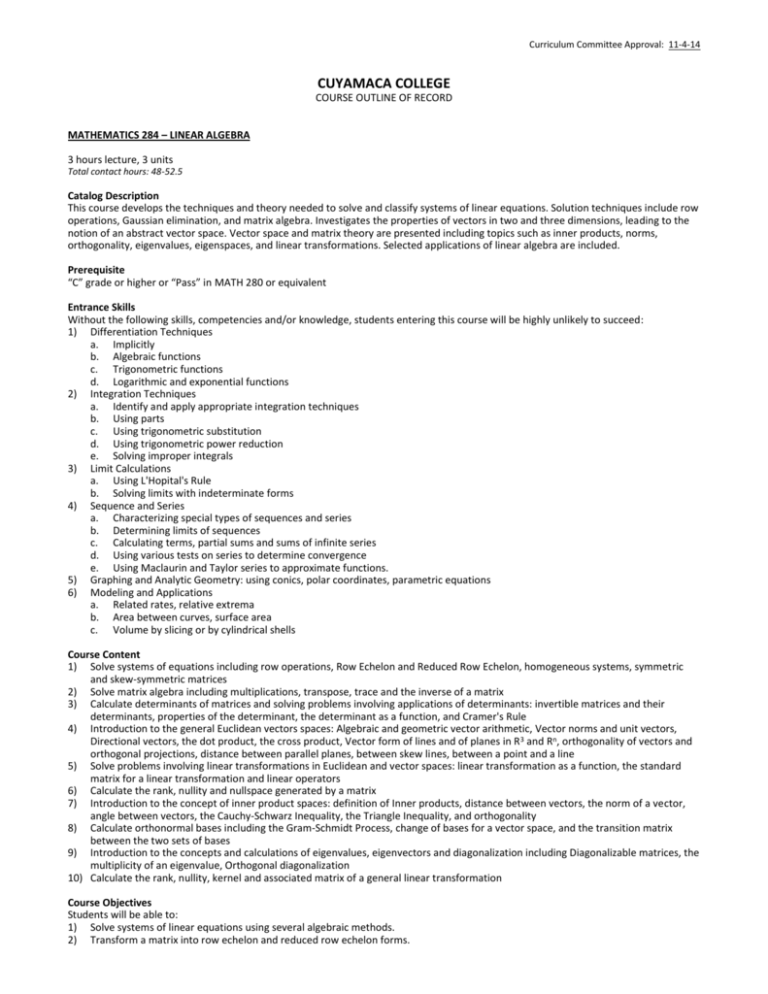
Curriculum Committee Approval: 11-4-14 CUYAMACA COLLEGE COURSE OUTLINE OF RECORD MATHEMATICS 284 – LINEAR ALGEBRA 3 hours lecture, 3 units Total contact hours: 48-52.5 Catalog Description This course develops the techniques and theory needed to solve and classify systems of linear equations. Solution techniques include row operations, Gaussian elimination, and matrix algebra. Investigates the properties of vectors in two and three dimensions, leading to the notion of an abstract vector space. Vector space and matrix theory are presented including topics such as inner products, norms, orthogonality, eigenvalues, eigenspaces, and linear transformations. Selected applications of linear algebra are included. Prerequisite “C” grade or higher or “Pass” in MATH 280 or equivalent Entrance Skills Without the following skills, competencies and/or knowledge, students entering this course will be highly unlikely to succeed: 1) Differentiation Techniques a. Implicitly b. Algebraic functions c. Trigonometric functions d. Logarithmic and exponential functions 2) Integration Techniques a. Identify and apply appropriate integration techniques b. Using parts c. Using trigonometric substitution d. Using trigonometric power reduction e. Solving improper integrals 3) Limit Calculations a. Using L'Hopital's Rule b. Solving limits with indeterminate forms 4) Sequence and Series a. Characterizing special types of sequences and series b. Determining limits of sequences c. Calculating terms, partial sums and sums of infinite series d. Using various tests on series to determine convergence e. Using Maclaurin and Taylor series to approximate functions. 5) Graphing and Analytic Geometry: using conics, polar coordinates, parametric equations 6) Modeling and Applications a. Related rates, relative extrema b. Area between curves, surface area c. Volume by slicing or by cylindrical shells Course Content 1) Solve systems of equations including row operations, Row Echelon and Reduced Row Echelon, homogeneous systems, symmetric and skew-symmetric matrices 2) Solve matrix algebra including multiplications, transpose, trace and the inverse of a matrix 3) Calculate determinants of matrices and solving problems involving applications of determinants: invertible matrices and their determinants, properties of the determinant, the determinant as a function, and Cramer's Rule 4) Introduction to the general Euclidean vectors spaces: Algebraic and geometric vector arithmetic, Vector norms and unit vectors, Directional vectors, the dot product, the cross product, Vector form of lines and of planes in R 3 and Rn, orthogonality of vectors and orthogonal projections, distance between parallel planes, between skew lines, between a point and a line 5) Solve problems involving linear transformations in Euclidean and vector spaces: linear transformation as a function, the standard matrix for a linear transformation and linear operators 6) Calculate the rank, nullity and nullspace generated by a matrix 7) Introduction to the concept of inner product spaces: definition of Inner products, distance between vectors, the norm of a vector, angle between vectors, the Cauchy-Schwarz Inequality, the Triangle Inequality, and orthogonality 8) Calculate orthonormal bases including the Gram-Schmidt Process, change of bases for a vector space, and the transition matrix between the two sets of bases 9) Introduction to the concepts and calculations of eigenvalues, eigenvectors and diagonalization including Diagonalizable matrices, the multiplicity of an eigenvalue, Orthogonal diagonalization 10) Calculate the rank, nullity, kernel and associated matrix of a general linear transformation Course Objectives Students will be able to: 1) Solve systems of linear equations using several algebraic methods. 2) Transform a matrix into row echelon and reduced row echelon forms. MATH 284 3) 4) 5) 6) 7) 8) 9) 10) 11) 12) 13) 14) Page 2 of 2 Perform a variety of algebraic matrix operations including: a. Multiplication, b. Transpose, c. Trace, d. Determinant, and e. Inverse. Perform vector operations on vectors from Euclidean Vector Spaces including vectors from Rn. Perform linear transformations in Euclidean vector spaces including basic linear operators. Prove whether a given structure is a vector space. Determine if a set of vectors: a. Spans a vector space, and b. Is linearly dependent or independent. Find a basis and the dimension of a vector space. Calculate the: a. Rank, b. Nullity, c. Column space, and d. Row space of a matrix. Use inner product to determine the length of a vector and to describe the orthogonality of vectors. Perform changes of bases for a vector space including computation of the transition matrix, and Determine an orthonormal basis for the space using the Gram-Schmidt process. Compute all the eigenvalues of a square matrix including any complex eigenvalues, and determine their corresponding eigenvectors. Apply linear algebra techniques to solve real world problems. Method of Evaluation A grading system will be established by the instructor and implemented uniformly. Grades will be based on demonstrated proficiency in subject matter determined by multiple measurements for evaluation, one of which must be essay exams, skills demonstration or, where appropriate, the symbol system. 1) Independent exploration activities which measure students’ ability to analyze the connections between the algebraic and graphic representations of various types of vector spaces and matrices of linear transformations. 2) Quizzes and exams (and a comprehensive in-class final exam) which measure students’ ability to work independently to perform a variety of matrix operations, vector operations, prove a vector space, solve for the basis and compute eigenvalues. 3) Homework assignments in which students apply algebraic principles discussed in class to a series of practice problems to help them formulate questions and receive feedback from the instructor, tutors or classmates. 4) Select appropriate technology in which students apply algebraic principles discussed in class to projects in order to better understand abstract concepts. Special Materials Required of Student Scientific calculator or graphing calculator Minimum Instructional Facilities Smart classroom and computer lab Method of Instruction 1) Lecture and demonstrations using visual aids including but not limited to the computer, graphing calculator or videos 2) Group discussions and problem solving 3) Quiz and examination review 4) Homework and extended projects 5) Collaborative projects 6) Calculator and/or computer assignments Out-of-Class Assignments 1) Problem sets which include writing proofs 2) Exploratory activities and/or projects 3) Reading and/or writing assignments Texts and References 1) Required (representative example): Lay, Linear Algebra and Its Applications. 4th edition. Pearson, 2012. 2) Supplemental: None Student Learning Outcomes Upon successful completion of this course, students will be able to: 1) Find solutions of systems of equations using various methods appropriate to lower division linear algebra. 2) Use bases and orthonormal bases to solve problems in linear algebra. 3) Find the dimension of spaces such as those associated with matrices and linear transformations. 4) Find eigenvalues and eigenvectors and use them in applications. 5) Prove basic results in linear algebra using appropriate proof-writing techniques such as linear independence of vectors; properties of subspaces; linearity, injectivity and surjectivity of functions; and properties of eigenvectors and eigenvalues.

